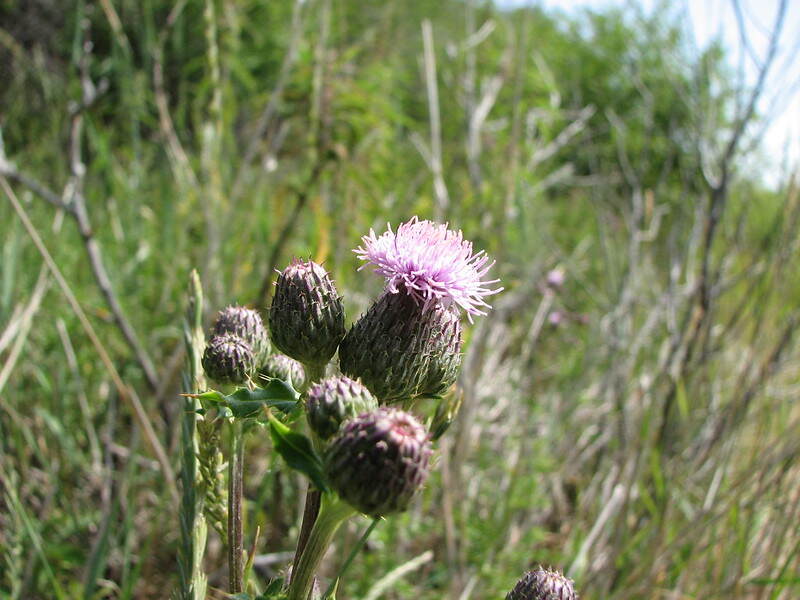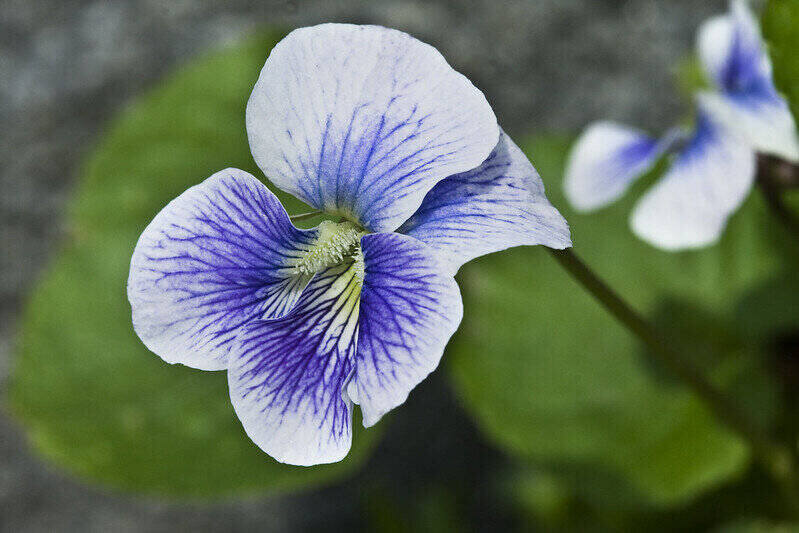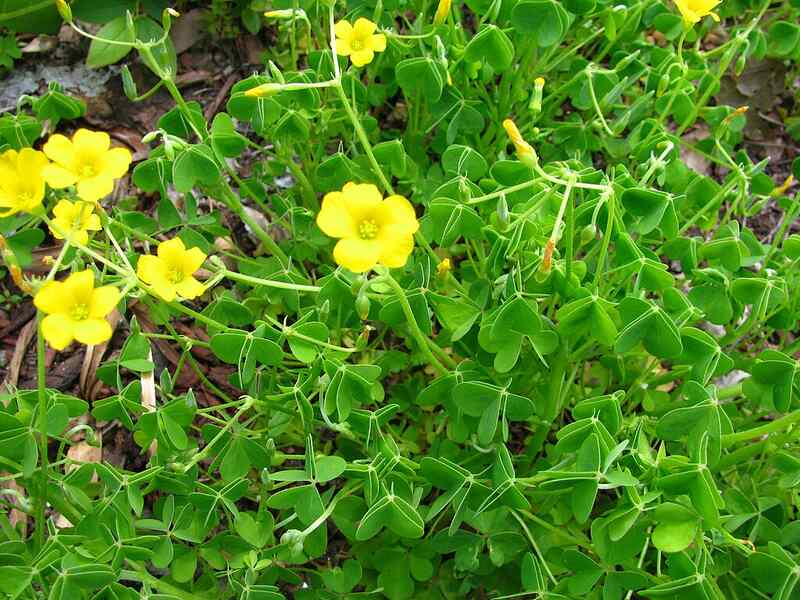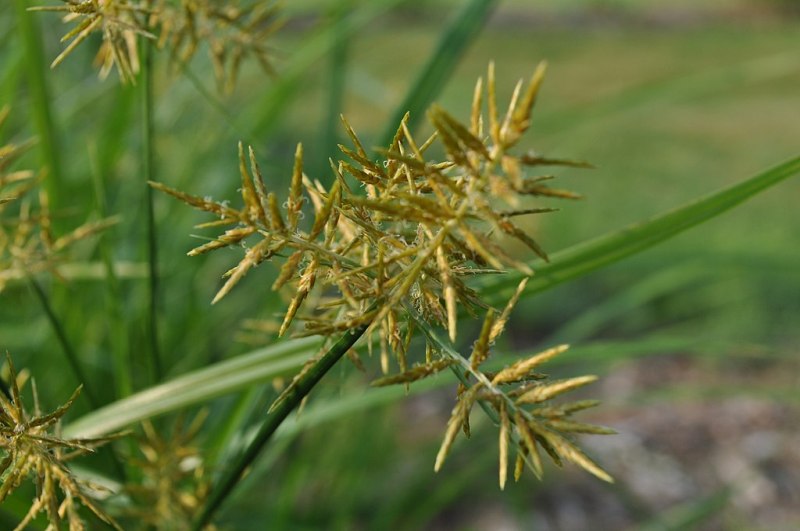
Controlling common lawn weeds like dandelion, ground ivy, crabgrass and wild garlic in New Jersey requires different approaches ranging from hand-pulling weeds to applying pre-emergent and post-emergent herbicides.
Each weed grows in different lawn environments, but a common thread is that if you’re seeing an increase in weeds, you probably have an issue with your lawn. While many weeds are invasive and persistent, it’s difficult for them to establish themselves if your lawn is healthy, lush, and robust. Your first line of defense against weeds is lawn maintenance.
Broadleaf Weeds
Broadleaf weeds often have, you guessed it, broad leaves. They also tend to have showy flowers and deep taproots. Many broadleaf herbicides are across-the-board effective, but not always. Double-check that the herbicide you choose will work on the weeds you’re dealing with. Always follow the manufacturer’s directions to the letter to avoid injury and poisoning.
Broadleaf Plantain (Plantago major)

Broadleaf plantain, also known as greater plantain, is an invasive, low-growing weed that’s a problem for lawns, pastures, gardens, and orchards because they crowd out and smother desirable, native plants and grass. They grow all over the United States but are most common in the Northeast and the western half of the country.
How to get rid of broadleaf plantain:
- Pull weeds by hand.
- Apply pre-emergent herbicides to limit plantain seedlings from growing.
- Post-emergent spot treatment to control plantains.
- Try a natural or homemade weed killer.
Canada Thistle (Cirsium arvense)

Canada thistle is a noxious weed that spreads via an aggressive and extensive root system and its copious parachute seeding. One plant can produce 2,000 viable seeds, especially if a female and male plant are close together. Canada thistle is a big problem for lawns, pastures, farms, and gardens, smothering desirable plants and grass and reducing crop yields.
How to get rid of Canada thistle:
- Due to the Canada thistle’s extensive reproductive root system, hand pulling is difficult.
- Mow the plants just before the flower buds open. It is important to avoid mowing when the plant has already produced seeds, as this can further spread the thistle.
- Apply pre-emergent herbicides in early spring and post-emergent herbicides for spot treatment.
Creeping Speedwell (Veronica filiformis)

Creeping speedwell, also called slender speedwell, is considered a desirable plant and a weed, depending on the situation. This low-growing plant is often used as ground cover, on slopes for erosion control, and in rock, water, and butterfly gardens. However, its creeping, mat-forming, aggressive growth will smother even the hardiest of turfgrasses if left unmanaged.
How to get rid of creeping speedwell:
- Hand-pull or trim if you’re using it in your landscaping.
- Pre-emergent in early spring to prevent growth.
- Post-emergent is effective for management and removal.
If you’re considering creeping speedwell for your yard, also consider these great perennials for your New Jersey landscape.
Dandelion (Taraxacum officinale)

While dandelions can benefit you and your yard, they lure pollinators away from your trees and plants. They’re also difficult to get rid of due to their large, thick taproot and crown buds. Dandelions are very hardy, withstanding frost, crowding, heat, and drought. Their stem produces a milky white latex substance that affects people with a latex allergy.
How to get rid of dandelions:
- Hand-pulling can be difficult because of the deep taproot. Mulch could be used as a non-chemical option.
- Apply post-emergent in late summer or early fall.
- Pre-emergents are not effective.
For more information, check out our article, “How to Get Rid of Dandelions.”
Ground Ivy (Glechoma hederacea)

Also known as creeping Charlie, ground ivy is invasive, pushing out plants and grass. It grows in most of America but especially the eastern half, including New Jersey. It’s a ground cover plant, spreading through above-ground runners called stolons. At each node, roots attach to the earth, extending up to 7 feet. Ground ivy is difficult to remove due to its roots and long-lasting seeds.
How to get rid of ground ivy:
- Hand-pulling roots can be difficult due to the multiple attachment points.
- Keep your lawn healthy. Ground ivy has trouble establishing itself in dense healthy lawns. For more information about keeping your lawn healthy, check out our article, “Spring Lawn Care Guide for New Jersey.”
- When flowers arrive in spring, apply a post-emergent broadleaf herbicide.
Henbit (Lamium amplexicaule)

Native to Europe, Henbit gets its name from being a yummy snack for hens. It’s a member of the mint family, but its aroma isn’t as distinct as some of its relatives. Henbit’s extensive fibrous root system means it’s excellent for erosion control, but difficult to remove from your lawn and garden. It can overtake and smother desirable plants and grass, especially thin patches.
How to get rid of henbit:
- Proper lawn care. Follow fertilization, mowing, and watering schedules for thick, healthy grass. Weed and feed your lawn in early spring or late fall.
- Apply pre-emergents as soon as the snow thaws and in the summer. Use post-emergents as needed.
- Smoothly pull the plant by the base, bringing up the roots with it. It can be challenging to remove all the roots.
Mugwort (Artemisia vulgaris)

Mugwort, also called wild chrysanthemum, felon herb, and wild wormwood, is native to Eurasia and grows primarily in the northeast and northwest. In New Jersey, it’s considered an invasive species due to its aggressive, quickly spreading rhizomes. Studies have found that it has components that may inhibit nearby plant growth. It can cause contact dermatitis.
How to get rid of mugwort:
- Persistent rhizomes make hand-pulling the weed quite difficult. Wear gloves to avoid contact dermatitis.
- Pre-emergent in late summer or early fall.
- Post-emergent as soon as you spot the weed. Multiple applications may be necessary.
Purslane (Portulaca oleracea)

A big problem for gardens and newly seeded lawns, purslane is a succulent that grows in every state but Alaska. Although purslane doesn’t land on the invasive weed list, it grows aggressively, sucking up nutrients, and is notoriously difficult to remove. Purslane can reroot if a part of the root or leaf is left in the soil and produces 50,000 seeds.
How to get rid of purslane:
- Proper lawn care: Purslane usually invades unhealthy lawns, so following a mowing, watering, fertilization, etc. schedule will help prevent the weed from establishing.
- Apply pre-emergent in spring or late winter.
- Apply post-emergent herbicides for spot treatment. Make sure you have the right type of post-emergent herbicide.
Ragweed (Ambrosia artemisiifolia)

Native to North America, ragweed grows throughout the United States, including New Jersey. It goes by many names including American wormwood, hay fever weed, bitterweed, blackweed, and carrot weed. Males of this summer annual release pollen in late summer and fall causing allergies, hay fever, and contact dermatitis. The pollen causes allergies in dogs too.
How to get rid of ragweed:
- Hand-pull the plant out of the ground. This should be done before August 1st to prevent the plant from pollinating and forming seeds for the next generation.
- Pre-emergents should be applied in the spring.
- Apply post-emergent for spot treatment.
Spotted Spurge (Euphorbia maculata)

Spotted spurge has several other common names including spotted euphorbia, spotted sandmat, prostrate spurge, and milk-purslane. This quick-spreading plant is found on roadsides, sidewalk cracks, gardens, and thinning grass. Spotted spurge is toxic for humans and pets and can cause contact dermatitis. Its sap contains latex, which can cause allergic reactions.
How to get rid of spotted spurge:
- Prevent germination by mulching (some places will give you mulch for free). Hand-pull or hoe out the weeds, preferably before they produce seeds. Wear gloves when hand-pulling these weeds to prevent skin irritation or contact dermatitis.
- Pre-emergent herbicides should be applied before the soil temperature exceeds 60ºF and before seeds have sprouted.
- Use post-emergent herbicides for spot treatment.
White Clover (Trifolium repens L.)

Calling clover a weed is a bit controversial because some experts say there are many reasons to plant a clover lawn. However, if you’re trying to upkeep a traditional turfgrass lawn, white clover is a problem. It can crowd out grass, especially if your turf type is slow-growing and non-aggressive. It’s pollinator-friendly, but that also means a lawn full of bees.
How to get rid of white clover:
- Use well-adapted turfgrass to help improve turf density. If you’re not sure if you have the right grass type, check out our article, “Best Grass Seed for New Jersey.”
- Practice good lawn maintenance. A healthy lawn is one of the best defenses against white clover.
- Apply pre-emergent in early spring and post-emergent for spot treatment.
For more information, check out our article, “How to Get Rid of Clover and Not Kill Grass.”
Wild Violet (Viola sororia)

Native to North America, wild violet grows from Maine to Florida and as far west as Texas and the Dakotas. Although it’s also used in rock, pollinator, edible (and more) gardens, its aggressive growth and self-seeding make it challenging to manage. It can quickly invade your lawn and nearby flower beds, especially in ideal conditions.
Note: If you’re considering wild violet for your pollinator garden, learn more about it and other pollinator-friendly plants in our article, “Native Plants Perfect for Your Butterfly Garden.”
How to get rid of wild violet:
- Hand-pull, making sure all rhizomes are out.
- Proper lawn care. Regular fertilization, mowing, and using turfgrasses that are well-suited to your specific site conditions can all help to increase turf density. Try one of the best weed and feeds for an additional lawn boost.
- Pre-emergent and post-emergent herbicides. Multiple applications may be necessary.
Yellow Wood Sorrel (Oxalis stricta)

Yellow wood sorrel, also known as common yellow oxalis and sour grass, is a native weed found in the eastern half of the US. When the plant is ready to seed, it constricts the seed pod until it explodes, sending the seeds soaring several feet. To distinguish between clover and oxalis, look at the leaves: yellow woodsorrel’s are heart-shaped but clover’s are oval.
How to get rid of yellow woodsorrel:
- Proper lawn care, including regular mowing, following a fertilization guide, and using appropriate turfgrass for the region.
- Hand-pull or dig out all rhizomes and roots before they flower or form seeds.
- Apply pre-emergents in early spring.
- Post-emergent herbicides when they sprout.
Grass-Like Weeds
Grass-like weeds resemble grass, but they normally have something that sets them apart from turfgrasses.
Smooth Crabgrass (Digitaria ischaemum)

Both smooth crabgrass and large crabgrass are a problem for New Jersey lawns. The only major differences are large crabgrass is bigger and hairier, and since smooth crabgrass is more prevalent in New Jersey, we’ll focus on smooth crabgrass. Smooth crabgrass grows in meadows, sidewalk cracks, along roads, and lawns, particularly unhealthy lawns.
How to get rid of crabgrass:
- Proper lawn care. Fertilize, water during dry conditions, and use well-adapted turfgrasses, mow regularly and at the right height for your grass type.
- Apply a pre-emergent herbicide in the early spring before the seeds sprout.
- Apply a post-emergent: Spot spraying with a targeted herbicide throughout the summer if crabgrass has already taken hold.
For more information, check out our article, “How to Get Rid of Crabgrass in Your Yard.”
Wild Garlic (Allium vineale L.)

Wild garlic, also called onion grass, is native to Europe, Africa, and the Middle East but now grows across the world, including the eastern US and New Jersey. Considered a noxious weed by the USDA, it seeds aggressively by seeds, aerial bulblets, and underground bulb offsets. It emerges and flowers in the spring, goes dormant in the summer, and reemerges in the fall.
How to get rid of wild garlic:
- Pull out by hand if you have a small number of weeds. For best results, try to dig them out with a thin trowel when the soil is moist.
- Mowing regularly won’t eliminate wild garlic but it can hamper bulb production and reduce plant vigorous growth.
- Pre-emergents are typically ineffective
- Post-emergents are somewhat effective but will likely require multiple applications.
Sedges
Sedges are all members of the Cyperaceae family. They grow aggressively, typically through tubers and rhizomes, although many also produce seeds.
Yellow Nutsedge (Cyperus esculentus)

Native to North America, yellow nutsedge is considered a major weed in the northeast. It goes by many names, including nutgrass, watergrass, earth almond, and more. It’s an aggressively growing plant due to its quickly spreading rhizomes and tubers. Although it produces seeds, new plants typically form from the rhizomes and tubers, which are difficult to remove.
How to get rid of yellow nutsedge:
- Hand-pull the emerging leaves early and frequently. Tubers and rhizomes left behind will sprout new yellow nutsedge.
- Pre-emergent herbicides are not effective.
- Yellow nutsedge-specific post-emergent herbicides are effective but may require multiple applications. It’s best applied in spring or early summer to avoid new rhizome growth.
For more information, check out our article, “How to Control Nutsedge in Your Yard.”
Frequently Asked Questions About New Jersey Weeds
What is a lawn weed?
A lawn weed is any plant that grows where you don’t want it to grow. Lawn weeds often mean bigger problems. Weeds invade when your soil is compacted, the soil isn’t properly fertilized, water isn’t draining correctly, you don’t mow at the right height, the grass isn’t watered, the garden beds aren’t maintained…the list of potential lawn issues is endless.
For more information, check out our article, “Read Your Weeds: Identify Them to Learn About Your Lawn’s Health.”
Are there any harmful lawn weeds in New Jersey?
Yes, there are harmful weeds, like poison ivy, that are unwanted and considered harmful.
Poison ivy can cause a painful itchy rash when touched. The rash is caused by an oil called urushiol, found in all parts of the plant, including the leaves, stems, and roots. Carefully remove poison ivy growing in your yard.
What happens if you don’t get your lawn weeds under control?
If you don’t get your lawn weeds under control, they’ll continue to compete with the desired turf for water, nutrients, and light. Over time, your lawn will deteriorate, choking the life of your lawn and ruining your curb appeal. Furthermore, weeds are a symptom of an underlying problem like poor drainage, compaction, etc. Ignoring weeds means ignoring the bigger problem.
Should I Hire a Professional for Weed Control?
If you enjoy lawn care and have the time to mow, water, fertilize, aerate, dethatch, etc. you’ll probably be just fine with DIY weed control. But if you’re like many Americans, you may not have the time, energy, or frankly, the desire to deal with yet another outdoor-related task. Homeowners all over New Jersey are bringing in professionals to whack their weeds.
But weeding through lawn care services to find one that’s affordable, experienced, and effective can be more of a headache than the weeds. That’s where LawnStarter can help. We’ve researched and vetted tons of local lawn care pros so you don’t have to. Soon, you’se guys’ll be weed-free and back to enjoying the Shore, pork rolls, and pies. Weed problems? Fuggetaboutit!
Main Image Credit: Henbit / Andy Reago & Chrissy McClarren / Flickr / CC BY 2.0